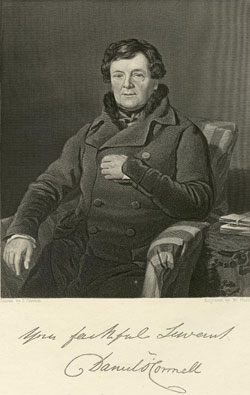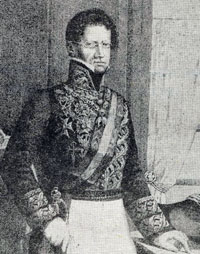| Deeply
moved by these revelations, Madden offered the family
what little he could by way of financial assistance. On
the tiny Derry plantation nearby, he discovered
the exact site where, forty years earlier, one of his
uncles, old Garrett Forde, was laid to rest. With a sense
of Shakespearian irony, he observed that the soil covering
the spot had begun to sprout the planter’s beloved sugar
canes. Undoubtedly, the unforeseen encounter with his
Jamaican relatives had a profound impact on Madden, infusing
him with an even greater desire to eradicate slavery in
all its forms (Madden 1891).
Much
to the dismay of colonial officials preoccupied with the
‘sacred rights of property’, as Special Magistrate, Madden
viewed emancipated slaves as British subjects, entitled
to all the protections enjoyed by white subjects under
the law. The duties of the Special Magistrates under the
1833 Abolition Act were ‘extensive but vague’ (Burn 1937:
203); they had exclusive jurisdiction over relations between
apprentices and their former masters. The arduous workload
involved regular tours of inspection on horseback over
a rough terrain, frequently mountainous, covering a radius
of as much as thirty miles.
Duties
included regular visits to jails and workhouses. The Special
Magistrates were required to fix the value of slaves who
wished to purchase their freedom. They also had to find
suitable locations to hold court. When there was a dispute,
Madden insisted upon equal treatment of apprentices in
his court, refusing to hear cases in which coercion had
been used to bring the accused before him. In response,
he faced obstruction by the powerful Council of Kingston,
which maintained its own police force and resented the
imposition of Special Magistrates by the London government.
In
the course of his duties, Madden befriended Benjamin Cochrane,
otherwise known as Anna Moosa or Moses. A native Arabic
speaker and son of a Mandinka chief, Anna Moosa was a
skilled doctor with a practice in Kingston where he administered
popular medicine, demonstrating considerable expertise
with medicinal plants. Madden also struck up a friendship
with Aban Bakr Sadiki (Al-Saddiq), a Muslim scholar and
native of a region bordering Timbuktu, who had been kidnapped
thirty years earlier, transported to Jamaica, and sold
into slavery. Bakr was noted for his Arabic penmanship
and for the accounting ability that became invaluable
to the plantation owner who claimed him as his property.
To Madden he was ‘as much a nobleman in his own country
as any titled chief is in ours’ (Madden 1835: 158). Expressing
his regard for this extraordinary individual, Madden later
wrote, ‘I think if I wanted advice in any important matter
in which it required extreme prudence and a high sense
of moral rectitude to qualify the possessor to give counsel,
I would as soon have recourse to the advice of this poor
negro as any person I know’ (Madden 1835: 158). With some
difficulty, he managed to secure Bakr’s manumission and
passage back to Sierra Leone.
[4]
|

A
portrait of ‘The Liberator,’ Daniel
O’Connell. The publication of Madden’s A
Twelvemonth Residence in the Island of Jamaica (1835)
prompted the Jamaican government to establish a
committee ‘to inquire into the working of the
apprenticeship system in the colonies’ at which
Madden testified that, essentially, the
apprenticeship system was slavery in another form.
O’Connell was a member of this committee.
|
Inevitably,
Madden’s activities led to clashes with employers of apprentices.
On one occasion, when a dispute between a planter and
his apprentice erupted in his court, the irate employer
threatened to have him ‘tarred and feathered’. Without
the support of local law enforcement, his situation became
untenable. Refusing to be intimidated, he was obstructed
and assaulted on a Kingston street, until two other Special
Magistrates intervened and threatened to call in the troops.
Eventually, Madden was forced to resign his position and
return to London noting, ‘I found the protection of the
negro incompatible with my own’ (Madden 1891: 72).
Upon
returning to London, Madden published the two-volume A
Twelvemonth Residence in the Island of Jamaica (1835),
using as a device an epistolary format whose addressees
included prominent literary figures, such as the poet,
Thomas Moore. The book had a considerable effect on public
opinion in Britain (Burn 1937: 221). The work prompted
the government to establish a select committee whose membership
included Daniel O’Connell, ‘to inquire into
the working of the apprenticeship system in the colonies’,
at which Madden testified that, essentially, the apprenticeship
system was slavery in another form. Along with two other
Special Magistrates, he described the difficulties and
abuses inherent in the Jamaican system, but went further
than the others in condemning it as a failure, offering
‘no security for the rights of the negro, no improvement
in his intellectual condition’. His efforts, along with
those of Joseph Sturge and members of the anti-slavery
movement, led to the early abolition of the apprenticeship
system in 1838, two years prior to the date fixed by the
Emancipation Act.
Apart from documenting the inoperability of apprenticeship,
the 1835 work is replete with descriptions of Jamaica’s
flora and fauna based on the author’s observations.
[5]
The appendix to the London edition also provides an insight
into Madden’s views of US policy. Written in the form
of satirical verse, the following lines reflect Irish
opinion as articulated by Daniel O’Connell:
O Hail! Columbia, happy land!
The cradle land of liberty!
Where none but negroes bear the brand,
Or feel the lash of slavery.
Following the signing of the Anglo-Spanish treaty of 1835,
Madden prepared to set sail once again, this time for
Havana, Cuba, the centre of the slave trade. Even before
he set foot on the island in the summer of 1836, the Irishman’s
appointment by the Colonial Office under Lord Glenelg
‘for his merit and character’ (Madden 1891: 75) as Judge
Arbitrator and first Superintendent of Liberated Africans
caused a flurry of diplomatic activity between Cuba and
Spain.
|

A
portrait of Captain General Miguel Tacón y
Rosique. Tacón attempted unsuccessfully to block
Madden’s appointment as Judge Arbitrator,
describing Madden as un
hombre peligroso (‘a dangerous man’) based
on his abolitionist views and activities in
Jamaica.
|
Describing Madden as un hombre peligroso,
(‘a dangerous man’) based on his abolitionist view and
activities in Jamaica, the Captain-General, Miguel Tacón, attempted unsuccessfully to block his appointment.
Madden was also appointed Judge Arbitrator on the International
Mixed Commission Court for the Suppression of the Slave
Trade in Havana under Lord Palmerston at the British Foreign
Office.
[6]
In
accordance with the anti-slave trade treaties, slaves
from condemned vessels were to be liberated and employed
as either free labourers or servants. Since he was charged
with securing the safety of emancipados, or freed
slaves, Madden was set on a collision course with the
ruling saccharocracy. His plan was to transfer the emancipados
from captured vessels to British colonies as free labourers.
Tacón, however, refused to allow the emancipados
to come ashore while awaiting a vessel to transport them
to British colonies, on the pretext that they would transmit
cholera or some other contagious disease. As Madden clearly
pointed out, Tacón had no difficulty allowing enslaved
Africans ashore in chains at out-of-the-way places around
the Cuban coastline. From the perspective of the Captain-General,
only emancipated Africans posed a threat to inhabitants
as ‘pestilential persons’ with their capacity to spread
‘a contagion of liberty’ throughout the island. A confidential
dispatch from Tacón to the Spanish government confirmed
that Madden’s views as an abolitionist unnerved the Captain-General
more than any other concern at that time.
|


